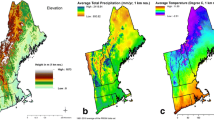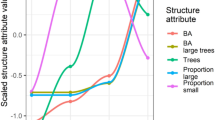Abstract
Forest compositional patterns in Yosemite National Park, California, were related to environmental factors through numerical classification of forest types, arrangement of forest types along elevational and topographic gradients, and development of regression models relating basal area of common tree species to environmental variables. The eight forest types are differentiated primarily by elevation zone and secondarily by topographic setting. Lower montane forests (1200–1900 m) were divided into the Abies concolor/Calocedrus type occurring primarily on mesic sites and the Pinus ponderosa/Calocedrus type predominantly on xeric sites. Upper montane forests (1900–2500 m) included the Abies concolor/Abies magnifica type on mesic sites, the Abies magnifica/Pinus type on somewhat more xeric sites, and Juniperus occidentalis/Pinus jeffreyi woodlands on granitic domes. Subalpine forests (2500–3300 m) embraced three types: Tsuga mertensiana/Pinus forests on mesic sites, monotypic Pinus contorta forests on drier sites, and Pinus albicaulis/Pinus contorta groves at treeline. Regression models consistently included elevation and soil magnesium content as explanatory variables of species basal area totals. The two Abies spp. were negatively correlated with soil magnesium levels, whereas other montane species (e.g. Calocedrus decurrens, Pinus lambertiana, and Pinus ponderosa) exhibited positive correlation with soil magnesium. Topography and soil physical properties were only infrequently incorporated into species regression models.
Similar content being viewed by others
Abbreviations
- DBH=:
-
diameter at breast height (1.4 m)
- DCA=:
-
detrended correspondence analysis
- TWINSPAN=:
-
two-way indicator species analysis
References
Austin, M.P. 1987. Models for the analysis of species' response to environmental gradients. Vegetatio 69: 35–45.
Austin, M.P., Cunningham, R.B. & Fleming, P.M. 1984. New approaches to direct gradient analysis using environmental scalars and statistical curve-fitting procedures. Vegetatio 55: 11–27.
Axelrod, D.I. 1981. Holocene climatic changes in relation to vegetation disjunction and speciation. Am. Nat. 117: 847–870.
Barbour, M.G. 1988. California upland forests and woodlands. In: Barbour, M.G. & Billings, W.D. (eds), North American terrestrial, vegetation, pp. 131–164. Cambridge University Press. Cambridge.
Berry, B.J.L. & Baker, A.M. 1968. Geographic sampling. In: Berry, B.J.L. & Marble, D.F. (eds), Spatial analysis: a reader in statistical geography, pp. 91–100. Prentica-Hall. Englewood Cliffs, New Jersey.
Bouyoucos, G.J. 1962. Hydrometer method improved for making particle size analysis of soils. Agron. J. 54: 464–465.
Draper, N.R. & Smith, H. 1981. Applied regression analysis, 2nd ed. John Wiley and Sons. New York.
Eyre, F.H. (ed.). 1980. Forest cover types of the United States and Canada. Society of American Foresters. Washington, D.C.
Forsythe, W.L. & Loucks, O.L. 1972. A transformation for species response to habitat factors. Ecology 53: 1112–1119.
Frank, E.C. & Lee, R. 1966. Potential solar beam irradiation on slopes: Tables for 30° to 50° latitude. U.S.D.A. For. Serv., Rocky Mt. For. Range Exp. Stat. Res. Pap. RM-18.
Galehouse, J.S. 1971. Sedimentation analysis. In: Carver, R.E. (ed.), Procedures in sedimentary petrology, pp. 69–94. John Wiley and Sons, New York.
Goodall, D.W. & Johnson, R.W. 1987. Maximum-likelihood ordination — some improvements and further tests. Vegetatio 73: 3–12.
Gray, J.T. 1978. The vegetation of two California mountain slopes. Madroño 25: 177–185.
Helms, J.A. & Ratliff, R.D. 1987. Germination and establishment of Pinus contorta var. murrayana (Pinaceae) in mountain meadows of Yosemite National Park, California. Madroño 34: 77–90.
Hill, M.O. 1979. TWINSPAN a FORTRAN program of arranging multivariate data in an ordered two-way table by classification of individuals and attributes. Section of Ecology and Systematics. Cornell University. Ithaca, New York.
Hill, M.O. & GauchJr., H.G. 1980. Detrended correspondence analysis: An improved ordination technique. Vegetatio 42: 47–58.
Klikoff, L. 1965. Microenvironmental influence on vegetational pattern near timeberline in the central Sierra Nevada. Ecol. Monogr. 35: 187–211.
Klyver, F.D. 1931. Major plant communities in a transect of the Sierra Nevada Mountains of California. Ecology 12: 1–17.
Major, J. 1977. California climate in relation to vegetation. In: Barbour, M.G. & Major, J. (eds), Terrestrial vegetation of California, pp. 11–74. Wiley-Interscience. New York.
Margalef, R. 1957. Information theory in ecology. General Systems 3: 36–71.
Minchin, P.R. 1987. An evaluation of the relative robustness of techniques for ecological ordination. Vegetatio 69: 89–107.
Munz, P.A. & Keck, D.D. 1949. California plant communities. Aliso 2: 87–105.
National Oceanic and Atmospheric Administration. 1985. Climatological data annual summary: California 1985. National Climatic Data Center. Asheville, NC.
Oosting, H.J. & Billings, W.D. 1943. The red fir forest of the Sierra Nevada: Abietum magnificae. Ecol. Monogr. 13: 259–274.
Parker, A.J. 1982. Environmental and compositional ordinations of conifer forests in Yosemite National Park, California. Madroño 29: 109–118
Parker, A.J. 1984. Mixed forests of red fir and white fir in Yosemite National Park, California. Am. Midl. Nat. 112: 15–23.
Parker, A.J. 1986. Persistence of lodgepole pine forests in the central Sierra Nevada. Ecology 67: 1560–1567.
Peet, R.K. 1981. Forest vegetation of the Colorado Front Range: composition and dynamics. Vegetatio 45: 3–75.
Rundel, P.W., Parsons, D.J. & Gordon, D.T. 1977. Montane and subalpine vegetation of the Sierra Nevada and Cascade Ranges. In: Barbour, M.G. & Major, J. (eds), Terrestrial vegetation of California, pp. 559–599. Wiley-Interscience, New York.
terBraak, C.J.F. & Looman, C.W.N. 1986. Weighted averaging, logistic regression and the Gaussian response model. Vegetatio 65: 3–11.
terBraak, C.J.F. & Prentice, I.C. 1988. A theory of gradient analysis. Adv. Ecol. Res. 18: 271–317.
Thorne, R.F. 1976. The vascular plant communities of California. In: Latting, J. (ed.), Plant communities of southern California, pp. 1–31. Spec. Publ. 2, California Native Plant Society, Berkeley.
United States Department of Agriculture. 1975. Soil taxonomy: a basic system of soil classification for making and interpreting soil surveys. U.S.D.A. Soil Conserv. Serv., Agric. Handbook 436. U.S. Govt. Printing Office. Washington, D.C.
Ustin, S.L., Woodward, R.A., Barbour, M.G. & Hatfield, J.L. 1984. Relationships between sunfleck dynamics and red fir seedling distribution. Ecology 65: 1420–1428.
Vankat, J.L. 1982. A gradient perspective on the vegetation of Sequoia National Park, California. Madroño 29: 200–214.
Wahrhaftig, C. & Birman, J.H. 1965. The Quaternary of the Pacific mountain system in California. In: Wright, H.E. & Frey, D.G. (eds), The Quaternary of the United States, pp. 299–340. Princeton Univ. Press Princeton, New Jersey.
Weisberg, S. 1980. Applied linear regression, John Wiley and Sons, New York.
Wentworth, T.R. 1981. Vegetation on limestone and granite in the Mule Mountains, Arizona. Ecology 62: 469–482.
Yeaton, R.I. 1981. Seedling characteristics and elevational distributions of pines (Pinaceae) in the Sierra Nevada of central California: a hypothesis. Madroño 28: 67–77.
Yeaton, R.I. 1984. Aspects of the population biology of sugar pine (Pinus lambertiana) on an evevational gradient in the Sierra Nevada of central California. Am. Midl. Nat. 11: 126–137.
Author information
Authors and Affiliations
Rights and permissions
About this article
Cite this article
Parker, A.J. Forest/environment relationships in Yosemite National Park, California, USA. Vegetatio 82, 41–54 (1989). https://doi.org/10.1007/BF00217981
Accepted:
Issue Date:
DOI: https://doi.org/10.1007/BF00217981




